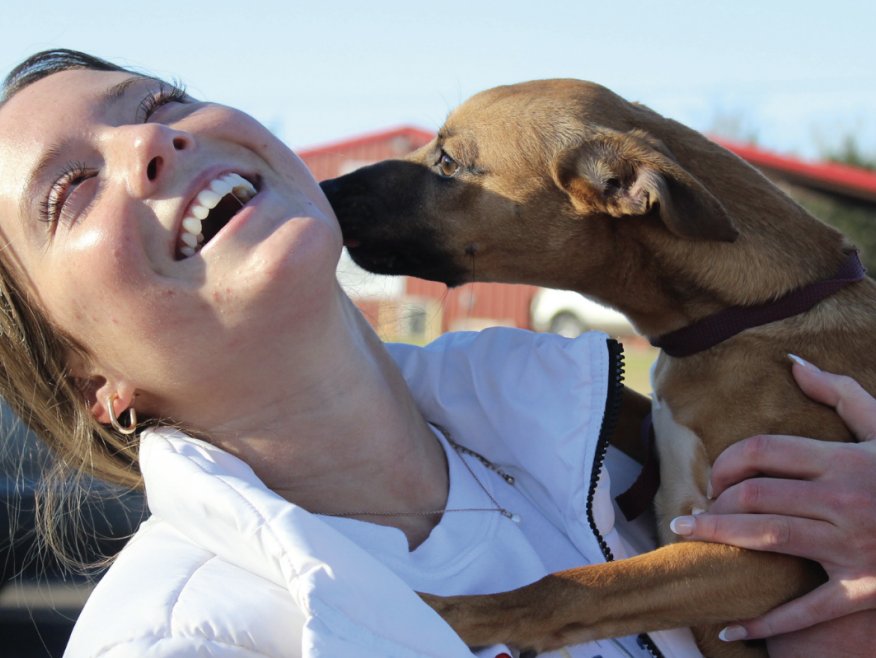It’s springtime and you know what that means — it’s puppies and kitten season. As much love and joy these common household pets bring to their families, many animals are left without homes and may need a little help to find families through local humane societies such as Aggieland Humane Society, which serves as a no-kill animal shelter.
In addition to finding homes for pets, Aggieland Humane Society helps to reunite lost pets with their owners and has a program to spay and neuter pets around the community to eliminate overpopulation issues. During the 2020-2021 year, the shelter found homes for 946 cats and 676 dogs, reunited 515 pets with their owners, and spayed and neutered 4,088 pets.
I remember countless hours being tugged by excited dogs and feline cuddles in the cat room when I volunteered at a humane society before starting college. Following staffers around Aggieland Humane Society, reinforced the simple act of volunteering at a shelter can have life-saving benefits for the animals looking for forever homes. To me, this is an opportunity to show pets extra love and attention, something I believe is super important to our community.
Aggieland Humane Society volunteer coordinator Nyssa Meyerdirk will be one of the first people to admit these shelter communities cannot run without volunteers. These individuals spend time with the animals helping to enrich their social skills and teach them mannerisms, which they may just need a little extra practice on.
“It’s just really providing that hands-on time with the animals and getting them used to just the way different people behave and the way they’re going to interact with them,” Meyerdirk said.
Starting with the volunteer application process through online and in-person training, the Aggieland Humane Society team ensures volunteers are ready to react in any situation presented.
“You’ll go through a couple of classes, teaching you about the shelter in general and our volunteer program,” Meyerdirk said. “Before you’re able to sign up for shifts, you’ll also go through what we call them enrichment training, basically learning a little bit of basic animal behavior, how to read body language for a dog or a cat [and] how to best use your time with them. We really stress that people
spend more time with an animal than trying to get to every animal in the kennel like they don’t seem to go out to go to the bathroom.”
Volunteering can go beyond time spent with animals, Meyerdirk said. They have worked to expand volunteer services to administration and the spay and neuter mobile clinic. Additionally, beyond the walls of the shelters, many volunteers open up their homes to any furry friends who may need 24/7 attention and care in the foster program.
These foster families such as Hannele Rubin and her daughter Calla, who foster kittens through foster2forever, have changed their day-to-day routines to take extra time to focus on the nurturing of animals.
“For the cats, I woke up at 7 [a.m.] and I would feed them, clean up their litter [and] play with them because they need lots of attention,” Calla said. “When I would get home [from school, I had to] do their water, clean then [and] clip their nails.”
Just as the philosophy I was taught from a young age, if I look to grow my family by four paws in addition to my cat, Ferguson, who was adopted from Bryan Animal Center, I will be sure to ‘adopt not shop’ to give a deserving animal a home who may not already have one.
Finding forever homes
April 29, 2022
Photo by Courtesy of Aggieland Humane Society
Aggieland Humane Society offers a variety of volunteer tasks including working with dogs and cats, administration and opportunities with their spay and neuter clinic.
0
Donate to The Battalion
$1915
$5000
Contributed
Our Goal
Your donation will support the student journalists of Texas A&M University - College Station. Your contribution will allow us to purchase equipment and cover our annual website hosting costs, in addition to paying freelance staffers for their work, travel costs for coverage and more!
More to Discover










